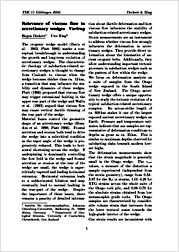Relevance of viscous flow in accretionary wedges
Deckert, Hagen
Ring, Uwe
Universitätsverlag Göttingen
Sammelband- / Konferenzbeitrag
Verlagsversion
Deutsch
Deckert, Hagen; Ring, Uwe, 2006: Relevance of viscous flow in accretionary wedges. In: Philipp, S.; Leiss, B; Vollbrecht, A.; Tanner, D.; Gudmundsson, A. (eds.): 11. Symposium "Tektonik, Struktur- und Kristallingeologie"; 2006, Univ.-Verl. Göttingen, p. 38 - 39., , DOI: 10.23689/fidgeo-1889.
 |
Dokument öffnen: |
The orogenic wedge model (Davis et
al. 1983; Platt 1986) marks a conceptual
breakthrough in understanding
the growth and long-term evolution of
accretionary wedges. The characteristic
rheology of subduction-related accretionary
wedges is thought to change
from Coulomb to viscous when the
wedge becomes thicker than ca. 15 km,
a transition that may influence the stability
and dynamics of these wedges.
Platt (1986) proposed that viscous flow
may trigger extensional faulting in the
upper rear part of the wedge and Wallis
et al. (1993) argued that viscous flow
may cause vertical ductile thinning of
the rear part of the wedge.
Material fluxes control the geometric
shape of an accretionary wedge (Brandon
et al. 1998; Platt 1986). Frontal
accretion and erosion both tend to drive
the wedge into a subcritical condition
as the taper angle of the wedge is progressively
reduced. This leads to horizontal
shortening across the wedge. If
underplating is dominantly controlling
the flow field in the wedge and frontal
accretion or erosion at the rear of the
wedge are small, the wedge is supercritically
tapered and leading horizontal
extension. Horizontal extension leads
to a subhorizontal foliation and may
eventually lead to normal faulting in
the rear-part of the wedge. Despite
the importance of these issues, there
remains a paucity of detailed information about ductile deformation and how
viscous flow influences the stability of
subduction-related accretionary wedges.
Strain measurements are an instrument
to address whether viscous flow strongly
influences the deformation in accretionary
wedges. They provide direct information
about the kinematics of ancient
orogenic belts. Additionally, they
allow understanding important tectonic
processes in subduction wedges such as
the pattern of flow within the wedge.
We focus on deformation analysis on
a suite of samples from the Otago
wedge exposed in the South Island
of New Zealand. The Otago accretionary
wedge offers a unique opportunity
to study the tectonic evolution of a
typical subduction-related accretionary
complex. Its across-strike length of
ca. 600 km makes it one of the largest
exposed ancient accretionary wedges on
Earth. Pressure and temperature estimates
indicate that our samples are representative
of deformation conditions to
depths as great as ca. 35 km. This is
similar to maximum depths observed for
subducting slabs beneath modern forearc
highs.
The deformation measurements show
that the strain magnitude is generally
small in the Otago wedge. The
oct
values, a measure of the distortion a
sample experienced (independent from
the strain geometry), range from 0.34–
3.87 for the Rf /? strains, 1.01–4.28 for
XTG strains across the whole suite of
the Otago rock pile, and 0.08–0.70 for
the absolute strains obtained from low
metamorphic grade rocks. The Otago
samples are characterized by considerable
volume strain that increases from
the lower textural zones towards the
high-grade interior of the wedge.
Our strain results are inconsistent with
the models which advocate supercritically
tapering of accretionary wedges
and that supercritical tapering eventually
triggers normal faulting. Taking
averages of our strain measurements,
a residence time in the wedge
of 35 Myr, burial depths of 30 km, coaxial
deformation and a depth-dependent
rate for ductile deformation, we calculate
vertically-averaged strain rates.
Because the principal strain axes of
the tensor average are all inclined, the
vertical averaging changes the principal
stretches. The horizontal principal
stretch parallel to the 160°-striking
Otago wedge becomes 0.79, that for
across strike 0.88 and for vertical
strain 0.44. Averaged strain rates are
−1.44−16 s−1 for parallel-strike horizontal
strain, −6.2−17 s−1 for across-strike
horizontal strain, and −8.02−16 s−1 for
vertical strain. The strain rates are related
to volume loss and to the efficiency
with which dissolved chemicals
are advected away. The rates are similar
to the ones calculated by Bolhar &
Ring (2001) and Ring & Richter (2004)
for the Franciscan wedge. These strain
rates are orders of magnitude smaller
than the 1−14 s−1 strain rates assumed
by Platt (1986). Thus, our data imply
that the Otago wedge could not shorten
horizontally fast, and hence could not
have steepened up its surface slope. The
fact that shortening was accompanied
by volume loss has another important
and interesting consequence. Even if
a case was envisioned in which horizontal
shortening was fast enough to
steepen up the surface slope of the
wedge, the volume loss would not necessarily
change the wedge geometry into
a supercritical configuration triggering
normal faulting. As a consequence of
the slow strain rates and the high volume
loss, viscous flow probably was not
fast enough to significantly influence the
stability of the wedge and to form a supercritically
tapered wedge.

